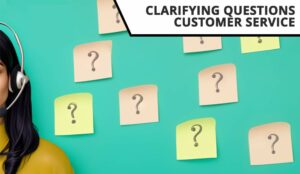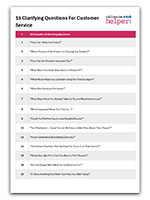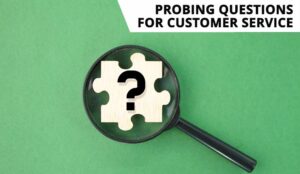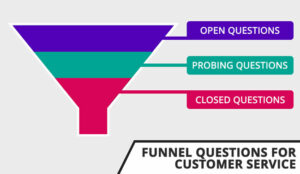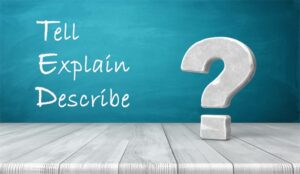When navigating customer service conversations, clear and targeted questions are essential to uncovering customer needs and concerns effectively.
From initial greetings to understanding the heart of an issue, these questions help customer service teams dive deeper, show empathy, and find solutions tailored to each unique situation.
We have gathered examples of clarifying questions (open, closed and probing questions) that add value to customer service conversations.
15 Clarifying Questions Examples
1. “How Can I Help You Today?”
Often, this is the only open question that advisors need to use. It gives customers the space to introduce their query and vent. The question can, therefore, work well as part of a greeting message.
2. “Which Feature of the Product is Causing You Trouble?”
When a customer response is vague and offers few specifics to drill into, this question helps advisors skip ahead to the heart of the issue.
3. “How Has the Situation Impacted You?”
Understanding the extent of an issue guide advisors to an appropriate solution. Such a question may also encourage customers to open up and discuss the emotional impact it has caused. If they do so, advisors can show empathy and deliver better customer service.
4. “What Were Your Main Attractions to Product X?”
When discussing a service issue, advisors may soon realize that a customer has selected a product/service that does not meet their needs. Asking questions like this helps advisors pair the customer up with a solution that suits them best.
5. “What Would Make You Consider Using Our Product Again?”
When a customer calls to complain, collecting feedback to pass on to management may help to devise actions that will improve future retention rates. Open questions like this are great for gathering uninhibited verbatim feedback.
6. “When Did the Issue First Arise?”
Discovering when a problem began is often critical to establishing a root cause. It also highlights how long the customer has been dealing with the issue. Such information may impact “next steps”.
7. “What Steps Have You Already Taken to Try and Resolve the Issue?”
Suggesting a solution that the customer has previously tried undermines the advisor’s expertise. So, if the customer indicates that they have attempted to solve the problem themselves, ask them what happened. Doing so may also provide some invaluable insights.
8. “What Happened When You Tried to…?”
Probe into the steps a customer has taken to resolve the issue. Avoid passing judgement. Instead, listen to the logic of their actions, work together, and problem solve.
9. “Could You Tell Me How it Looks/Smells/Sounds?”
Open questions offer an outline of the customer’s problem. Probing questions add colour, allowing advisors to visualize the issue.
With such an understanding, advisors can link the query with previous experiences to find possible solutions.
10. “You Mentioned… Could You Let Me Know a Little More About That, Please?”
Customers often give long-winded responses to open questions. A statement like this helps to focus the customer on the details that lead to a solution. Just be a little careful when starting sentences with “you”. Sometimes, it can seem accusatory.
Discover more excellent examples by reading our article: 17 Probing Questions to Improve Your Customer Service
11. “Have I Understood Everything Correctly?”
Encourage advisors to paraphrase problems back to customers and ask this question. It reassures the customer that they were listening closely and fully understand the issue. Advisors may also check that they have not overlooked crucial snippets of information.
12. “The Contact Number That We Have For You is X, is That Correct?”
Miscommunication is often the result of customers changing their contact information without informing a company. Such a closed question can quickly troubleshoot this issue.
13. “Would You Like Me to Call You Back in Five Minutes?”
Long periods where customers wait on hold while advisors look for information can lead to customer frustration.
To better bridge silences, offer a callback – with a time expectation – so the customer can continue with their day.
14. “Are You Happy With What You’ve Heard so Far?”
When a customer seems unsure about the progress of their call, offer them the chance to speak up. Doing so ensures that they feel heard. When dealing with vulnerable customers, this is especially important.
15. “Is There Anything Else That I Can Help You With Today?”
After solving a query, asking if the customer would like any extra support helps avoid a second call and is considered a common courtesy. Just be careful about using this question when the original issue has not been resolved.
Printable – 15 Clarifying Questions for Customer Service
Do you want to download this to share with your team?
Get your free download of 15 Clarifying Questions Examples now:
Use the Funnel Effect
When handling a call with no obvious process to follow, “The Funnel Effect” is an excellent technique to focus the conversation on a tangible solution.
The significance of this technique is that it encourages advisors to use a combination of open, probing and closed questions – in that order.
Indeed, the advisor starts with an open question to understand the issue. They then clarify the situation and ask a probing question to focus on specifics. Finally, they use closed questions to either confirm their understanding or move the conversation along.
As such, a call follows a flow as highlighted in the diagram below.
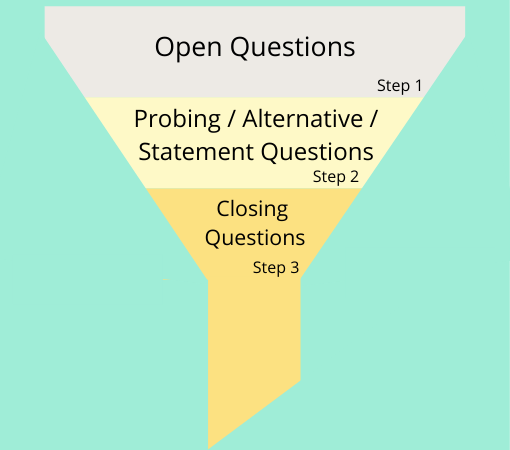
Open Questions
Open questions, such as “how,” “when,” “where,” and “what,” encourage customers to express their concerns in detail. This approach not only gathers essential information but also makes customers feel valued.
Advisors can enhance these interactions with verbal nods like “I see” to build rapport. However, questions beginning with “why” can make customers defensive and sour the conversation, so it’s best to avoid them.
Probing Questions
Probing questions help advisors dig deeper into a customer’s issues. According to Sara Odorisio from Hodos Training, “If an advisor is ever unsure of the reasons and emotions that are driving a call, they can use probing questions to discover more.”
Active listening is crucial here, as it allows advisors to tailor their questions effectively.
Closed Questions
Closed questions typically begin with “do,” “could,” “is,” “have,” or “what,” limiting responses to simple yes or no answers. These questions help keep conversations on track, especially when customers are rambling. While useful, these questions should always stay relevant to the situation at hand.
Example of the Funnel Effect
Consider the following conversation as an example of how the Funnel Effect works in practice.
The advisor begins the conversation with an open question. They then delve into the specifics of which details the customer wishes to change. Finally, the advisor dives into the heart of the matter with a closing question.
When using the technique, Sara Odorisio stresses that advisors avoid stringing questions together, instead recommending a “question, answer, comment” approach.

“Ask one question at a time,” she says. “Some advisors will ask two or three questions at a time, which is confusing as the customer doesn’t know where to begin their response.”
“Instead, coach advisors to ask one question, listen closely to the answer and reflect on the customer’s response with a comment before asking another question.”
Training advisors to refer back to the customer’s answer – perhaps by paraphrasing it and reflecting particular keywords – encourages them to listen more closely to customers.
Bridge the Questions Beforehand
Good questioning is central to excellent customer service. However, asking customers question-after-question can feel like an inquisition.
Of course, sometimes asking lots of questions is unavoidable. In these incidences, encourage advisors to introduce their questions with a friendly bridging message. Customer Service Specialist Myra Golden recommends the following statements:
- “To determine what happened, I will need to ask you some questions.”
- “Do you mind if I ask you some questions so we can figure out what has happened?”
- “So I can assist you, may I ask you a few questions?”
Using one of these statements helps to bridge into the questioning. Doing so removes the sense of being under interrogation from the customer’s mind.
If advisors also use common courtesies, such as “please” and “thanks”, they can create an even more pleasant experience.
For more examples of clarifying questions, read these articles next:
- Open Questions to Use in Customer Service
- How to Use Funnel Questions – With Examples
- 15 Examples of Probing Questions for Customer Service
Author: Charlie Mitchell
Reviewed by: Robyn Coppell
Published On: 14th Sep 2022 - Last modified: 25th Oct 2024
Read more about - Skills, Customer Service, Downloads, Editor's Picks, Language, Printable, Questioning Techniques, Soft Skills





